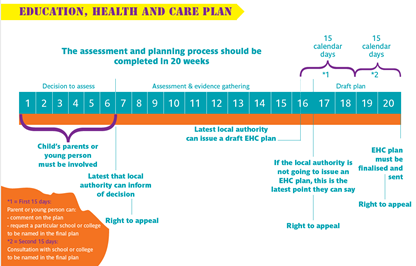
An Education, Health and Care Plan (EHCP) is a legal document which describes a child or young person’s special educational needs, the support they need, and the outcomes they would like to achieve.
An EHCP can only be issued after a child or young person has gone through the process of an EHC Needs Assessment.
Test in Law for an EHC Needs Assessment
The Local Authority (LA) must apply a legal test when considering whether or not to carry out an EHC Needs Assessment. This test is contained in section 36(8) of the Children and Families Act 2014 and has two parts.
Part one of the test is whether the child or young person has or may have special educational needs.
Please see below the definition of special educational needs as detailed in Part 3 Section 20 of the Children and Families Act 2014:
- Your child has a significantly greater difficulty in learning than the majority of others of the same age or
- has a disability that prevents or hinders him or her from making use of facilities of a kind generally provided for others of the same age in mainstream schools or mainstream post-16 institutions.
- A child under compulsory school age has a learning difficulty or disability if he or she is likely to be when of compulsory school age
Part two of the test is that it may be necessary for Special Educational Provision (SEP) to be made for the child/young person through the issuing of an EHC plan.
The Local Authority should not apply a higher threshold in law for assessing an EHC needs assessment.
Most children and young people with SEN or disabilities will have their needs met within local mainstream early years settings, school or colleges; however, some children and young people may require an EHC needs assessment in order for the Local Authority to decide whether it is necessary to make additional provision through an EHC.
If an EHC Needs Assessment takes place, the LA will decide as to whether an EHCP is needed for the child or whether the child's needs can be met in a setting without it.
EHC Needs Assessments
If they agree to carry out an EHC Needs Assessment, the LA must seek information and advice on a child or young person’s needs, the provision required to meet those needs, and the outcomes expected to be achieved by the child or young person. This advice must come from a range of different people, described below:
The LA must seek advice from a range of people. The list is set out in Regulation 6(1) of the Special Educational Needs and Disability Regulations 2014 (the “SEN Regs”):
- the child’s parent or the young person;
- educational advice (usually from the head teacher or principal);
- medical advice and information from a health care professional;
- psychological advice and information from an educational psychologist;
- advice and information in relation to social care;
- advice and information from any other person the local authority thinks appropriate;
- where the child or young person is in or beyond year 9, advice and information in relation to provision to assist the child or young person in preparation for adulthood and independent living; and
- advice and information from any person the child’s parent or young person reasonably requests that the local authority seek advice from.
The LA is legally required to seek all of this information as a minimum.
Statutory Time Scales for the EHC Process
Click image to view in large scale.

What will be included in an EHC plan if the LA agrees to issue it?
An EHC plan has sections A- K, three of which are legally binding Section B needs Section F provision (support), and section I the naming the setting or type of setting and it will be tailored to meet the particular needs of each child or young persons. The EHC plan will include information about your child/young person's views and aspirations, Information regards your child’s needs and support to be put in place to meet your child's needs, and outcomes will be also set for your child to aim to achieve
For more information please click here to view our resource pack
Further information can be found using the links below:
 EHC needs assessments (ipsea.org.uk)
EHC needs assessments (ipsea.org.uk)
 Children and Families Act 2014 (legislation.gov.uk)
Children and Families Act 2014 (legislation.gov.uk)
 SEND_Code_of_Practice_January_2015.pdf (publishing.service.gov.uk)
SEND_Code_of_Practice_January_2015.pdf (publishing.service.gov.uk)
 The Special Educational Needs and Disability Regulations 2014 (legislation.gov.uk)
The Special Educational Needs and Disability Regulations 2014 (legislation.gov.uk)
 SEND Myths
SEND Myths
 Council for Disabled Children
Council for Disabled Children










